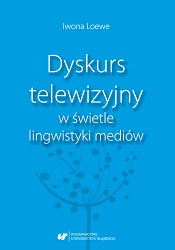Dyskurs telewizyjny w świetle lingwistyki mediów
Television discourse in the light of media linguistics
Author(s): Iwona Loewe
Subject(s): Social Sciences, Language and Literature Studies, Theoretical Linguistics, Applied Linguistics, Communication studies
Published by: Wydawnictwo Uniwersytetu Śląskiego
Keywords: media text; polylogue; logo visuality; multimodal text; visual linguistics
Summary/Abstract: The author assumes that television discourse belongs to culture and therefore it is semiotic, transmissible, and it preserves discourse community practices. To begin with, Loewe presents the state of research into television and next into television discourse in Polish philological studies. She indicates five dates which are crucial for the current state of knowledge. The model of discourse in this publication is based on three theories proposed by: Ewa Miczka (discourse linguistics), Piotr Sztompka (sociology), and Bożena Witosz (discourse stylistics). Its framework is formed by six parameters: ideational, normative, interactive, subjective, spatial, and chronemic. The ideational parameter: norms applied in the discourse and its governing rules are a media representation of a segment of reality. The reality is depicted to a recipient always from the perspective of a sender, whose goals are allocated in their vision of the world. The normative parameter: it is defined by the two phenomena: sociocultural table and media agreement. The sociocultural table describes the area of social, cultural, and political relations, which allows to create meanings in media discourses. Included in the media agreement is a contract about the synergy of audiovisual codes. The interactive parameter: a distinguishing feature of television discourse is transmissibility and topicality. The situational context orients the discourse transmission in one direction. The subjective parameter: the user of any discourse is a community. Its members are frequently called actors since they perform social roles. The discourse has a mass and dispersed audience. The spatial parameter: discursive practices are held in a space accessible to other participants of social life. This space is public, official, and knowable. The chronemic parameter: continuity, repetitiveness, and the cyclicality of multiple communicative acts ensure participation in the discourse and make this discourse. Based on these parameters, the author positions the center of discursive space and its other areas. The center includes: programmed television and profiled television. Further away from the center there is streaming television in the form of streaming audiovisuality (e. g. Player, Ipla, and VOD TVP), hybrid visuality (e. g. HbbTV), produced visuality (You Tube), portal audiovisuality (e. g. Onet, Wirtualna Polska), and on demand (e.g. Showmax, Netflix). In another part of her book, the author considers research problems concerning the central category of television discourse – multimodal text. She presents the result of research into media text, polylogue, logo visuality, and the discourse actors: the sender and the audience. An important place in this publication is the chapter on color in visual linguistics. Color is gaining relevance in TV programs recorded in a studio, in the layout of network identification and program identification, and in broadcast display format. Color can undergo a semiotic analysis. Television’s expectations to attract audiences by utilizing a system of auto-identification and auto-promotion have currently increased. Iconosphere plays a crucial role in these. Loewe states that the color blue used in television station logos, logotypes, the backdrop of news programs, and the newscaster’s attire objectifies contents and has a dominant interactive function. Colors used in the network identification primarily have an ideational function. Their appearance in the form of a television station logo, an auto-promotional banner, and a logotype for a network or a program informs about the network or the program. Color in the scheduled programming may answer a viewer’s question – what is it like? And color in the auto-promotional programming answers the question – what is it? The author’s interest in the topic was motivated by a well-known paradox. It is believed by some that the technological form of television sterilizes reality, which means dismissing pain or joy and creating intimate detachment. A different vision contains a conviction about the community’s need to celebrate. Confronting this paradox with television discourse and its parameters has become a research aim in this book. The author assumes that television discourse belongs to culture and therefore it is semiotic, transmissible, and it preserves discourse community practices. The book presents the state of research into television and next into television discourse in Polish philological studies. Loewe offers her own parametrization of television discourse and delineates its research area. A part of the book concerns multimodal text. The results of research into media text, polylogue, logo visuality, and the discourse actors: the sender and the audience have been presented. The book also addresses the significance of color in the content of television discourse.
Series: Radio, Telewizja, Film, Internet
- E-ISBN-13: 978-83-226-3545-2
- Print-ISBN-13: 978-83-226-3544-5
- Page Count: 190
- Publication Year: 2018
- Language: Polish
- eBook-PDF
- Table of Content
- Introduction

